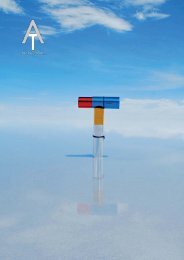Gaston Ugalde - INFO
Art publication with a selection of texts featuring the work of renowned artists Gaston Ugalde
Art publication with a selection of texts featuring the work of renowned artists Gaston Ugalde
Create successful ePaper yourself
Turn your PDF publications into a flip-book with our unique Google optimized e-Paper software.
Debajo de la capa de sal hay una
sustancia salmuera que contiene más
de la mitad de las reservas de litio
del mundo. Esto ha sido significativo
para Bolivia ya que estas reservas son
inmensamente valiosas, y han estado
durante muchos años en el proceso de
ser extraídas. El Presidente Evo Morales,
sin embargo, fue resistente a la presión
de los países industrializados para
extraer este litio, afirmando: “No vamos
a repetir la experiencia histórica desde
el siglo XV: materias primas exportadas
para la industrialización del Occidente
que nos dejó pobres.” El gobierno
boliviano procuraba proteger la sal de
los daños ambientales a largo plazo, al
mismo tiempo que defendió el inminente
colapso económico que situaría a los
bolivianos en la pobreza. Ugalde activa
este territorio social y políticamente
cargado a través de estas interjecciones
humanas. Al insertar instalaciones
humanas en estos paisajes inhóspitos y
estériles, representando a sus súbditos
como dominados, desamparados e
indefensos, Ugalde crea un sorprendente
contraste que es un ferviente comentario
sobre el valor de la naturaleza y la vida
humana en el contexto de comercio. La
impresionante estética del salar es, por
un lado, sobrenatural y trascendental,
por otro su futuro está plagado de
incertidumbre.
Beneath the salt layer is a brine substance
that holds more than half of the world’s
lithium reserves. This has been significant
for Bolivia as these reserves are hugely
valuable, and have been for many years in
the process of being extracted. President
Evo Morales, however, was resistant to
the pressure of industrialized countries
to extract this lithium, stating: “We
will not repeat the historical experience
since the 15th century: raw materials
exported for the industrialization of the
West that has left us poor.” The Bolivian
government attempted to protect the
salt pan from long-term environmental
damage, while simultaneously fending
off impending economic collapse that
would place Bolivian people further in to
poverty. Ugalde activates this socially and
politically loaded territory through these
human interjections. By inserting human
installations into these stark and barren
landscapes, depicting his subjects as
dominated, disempowered and helpless,
Ugalde creates a striking contrast that
is a fervent commentary on the value
of nature and human life against the
backdrop of commerce. The awe-inspiring
aesthetic of the salt pan is on the one hand
otherworldly and transcendental, on the
other its future is rife with uncertainty.
14 15



